The Story of the Todd-AO Projector
|
Read more at
in70mm.com |
||||||||||||||||||||||||||||||||||||||||||||||||||||||||||||||||||||||||||||||||||||||||||||||||||||||||||||||||||||||||||||
| Written by: Thomas Hauerslev | Date: 11.08.2019 | ||||||||||||||||||||||||||||||||||||||||||||||||||||||||||||||||||||||||||||||||||||||||||||||||||||||||||||||||||||||||||||
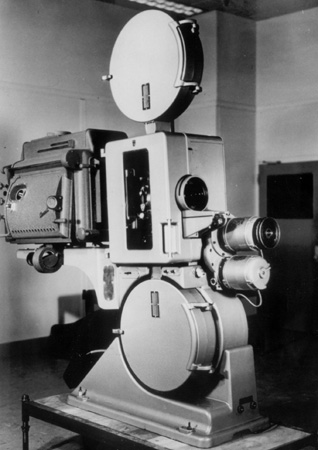 The DP70
prototype at American Optical's ½-scale cinema. Image by American Optical The DP70
prototype at American Optical's ½-scale cinema. Image by American OpticalThe DP70 70mm projector, or The Todd-AO projector, has its roots in CINERAMA, the first convincing "Puts you IN the Picture" type of cinema experience, which premiered in 1952. Broadway producer Michael Todd, initially VERY impressed with the demonstration of CINERAMA, called it "The Greatest thing since penicillin". He produced and directed the first half of the 3-strip demonstration film "This is CINERAMA". However, Mike Todd was frustrated with the technical limitations of the Cinerama process. As the story goes, he was displeased with CINERAMA's technology of three separate films and two visible "join lines" on the curved screen. The audience didn't seem to care, and was so impressed with CINERAMA and its convincing "first-person" illusion of reality, that it became the single most successful film of 1952 - and it only played in one cinema. Mike Todd had high ambitions and set out to improve the first-person experience - which CINERAMA did so brilliantly - without three projectors, join lines and high installation, and labour costs. His goal was a system with one strip of film and one projector, which eventually became the Todd-AO motion picture process. As Mr Todd so pithily put it, he wanted "CINERAMA out of one hole". The Todd-AO Process would be a combination of several things, including: "New Sight, New Sound and New Screen", as the adverts said. A team of more than 100 American Optical engineers would work for three years to develop what became the Todd-AO Process. New cameras, new curved screen, new sound equipment, new lenses, accessories and not the least: a new 70mm projector. A projector for 70mm film was needed. Unable to make one in-house, the development of the new Todd-AO projector was outsourced to the Philips Cinema company in Holland. Headed by Philips Cinemas chief designer Mr. Jan Jacob Kotte, Philips developed a 70mm machine which eventually would be a world wide success, and win an Oscar. An amazing achievement for the Eindhoven-based company in Holland. The Todd-AO Projector, Philips model EL4000/01, or DP70, as it was named, became the "Rolls-Royce" of 70mm film projectors, and eventually was installed in nearly 700 prestige cinemas all over the world. Few, if any, other 70mm projectors were surround by similar glitz and glamour in the '50s as was the DP70. Associated with Todd-AO, Rodgers & Hammerstein's popular musicals, and not least the flamboyant Broadway producer Mike Todd, Philips made good use of the press for their prestigious product with a long line of adverts in trade magazines. No other 70mm projector had the same aura of fame as the DP70 had. The DP70 was loved by projectionists everywhere, and to this day (2019) some machines are still in service nearly 65 years later, after the first premiere in 1955. |
More
in 70mm reading: DP70 - The Todd-AO Projector DP70 Story DP70 Cinemas everywhere DP70 Serial Numbers DP70s in Cinemas All over The World DP70 / AAII / The Todd-AO Projector serial numbers: 0600 - 2532 Modernizing the DP70 Todd-AO 70mm Projectors Internet link: kinoton.de Philips Museum |
||||||||||||||||||||||||||||||||||||||||||||||||||||||||||||||||||||||||||||||||||||||||||||||||||||||||||||||||||||||||||||
The Story of the Todd-AO Projector |
|||||||||||||||||||||||||||||||||||||||||||||||||||||||||||||||||||||||||||||||||||||||||||||||||||||||||||||||||||||||||||||
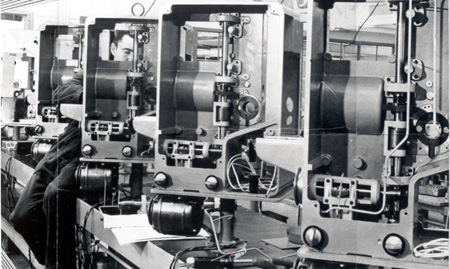 Assembly
line of DP70 machines. Assembly
line of DP70 machines.Michael Todd formed a company with several other investors, including Rodgers and Hammerstein II, Joe Schenk and George Skouras and named it MAGNA. The purpose of Magna was to develop a new wide screen process. Magna Theatre Corporation commissioned American Optical company to develop the system which was to be named Todd-AO. The purpose of the process was lined up like this:
For Todd-AO, a new projector was required. Unable to make one in-house, American Optical Company asked several US projector companies to build a new 70mm projector. None of them, however, believed a completely new 70mm projector could be ready in only nine months as required by MAGNA. Walter Siegmund recalls development of the DP70:
In September 1953 Magna Theatre Corporation approached Philips Cinema, a
division of Philips Electro Acoustics division (ELA) in Eindhoven, Holland. Dr.
Brian O'Brien, American Optical Company's Head of Research and Development knew
a tremendous number of people and he was well aware of Philips' projectors and
their reputation of excellence. |
|||||||||||||||||||||||||||||||||||||||||||||||||||||||||||||||||||||||||||||||||||||||||||||||||||||||||||||||||||||||||||||
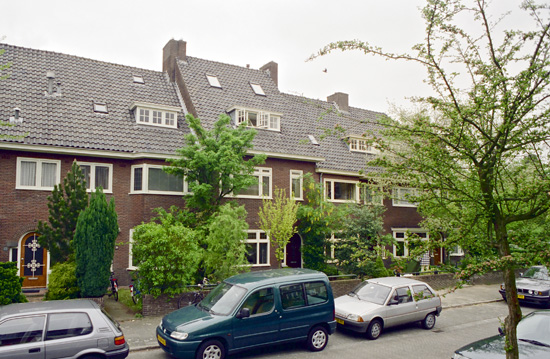 The
Todd-AO projector was developed in this house on Jacques Perkstraat in
surburbian Eindhoven. Picture by: Thomas Hauerslev The
Todd-AO projector was developed in this house on Jacques Perkstraat in
surburbian Eindhoven. Picture by: Thomas HauerslevTechnically responsible for Philips' cinema activities were: • Dr. J. de Boer, Technical Director (successor to H. Wildeboer) • P. Hinse, Manager Cinema Design Department • Jan Jacob Kotte, Chief Designer • P. Hoekstra, Designer Special Projects • A. A. Overmars, Manager Projector Assembly Department It was a revolutionary projector and so versatile it could show any film format except horizontal double frame VistaVision. The DP70 brochure proudly claimed:
The final version, however, did indeed require
change of gates, pressure rollers, pressure bands etc. With a handy storage
case containing all necessary parts for 35mm film, change-over from 70mm to 35mm could
be done in less than four minutes.
Philips claimed a four minutes conversion time, but that would be only the
mechanical parts and not other aspects such as checking screen illumination,
framing and centering. Jan Kotte worked day and
night with his colleagues and even went as far as installing a home-office in
Jacques Perkstraat in surburbian Eindhoven
with
a large drawing board. A work-from-home set-up was completely unheard of in
1953. |
|||||||||||||||||||||||||||||||||||||||||||||||||||||||||||||||||||||||||||||||||||||||||||||||||||||||||||||||||||||||||||||
Prototypes |
|||||||||||||||||||||||||||||||||||||||||||||||||||||||||||||||||||||||||||||||||||||||||||||||||||||||||||||||||||||||||||||
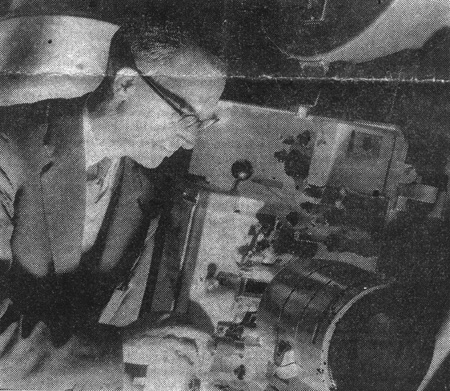 Jan
Jacob Kotte with a prototype DP70. Philips Newspaper clip, 1956. Jan
Jacob Kotte with a prototype DP70. Philips Newspaper clip, 1956.Towards the end of 1954 the first set of three DP70 pre-production models were delivered to Magna Theatre Corporation, and pictures began to appear in magazines. As of February 1955, "Oklahoma!" was expected to open in early May 1955. By April 1955, the opening had been moved back to July 17, 1955. The actual premiere for the public was 13. October 1955, following three days of invitational premieres. The design of the prototypes was a little different from the nearly 1500-1600 serially produced machines. The main differences were: • Mechanism door was mounted on the left side of the mechanism (door opened right to left) • Mechanism interior was painted in the Philips Hammer tone Epoxy paint finish like the rest of the machine. • The lens slide was significantly larger • Prototypes did not carry serial numbers. Prototypes are referred to as pre-production numbers X1, X2 etc. A pictures show Mr Kotte next to one prototype, most likely installed at Philips in Holland. One DP70 was installed at the American Optical Research Center in Southbridge (CT). It was a half-scale Todd-AO demonstration cinema with a curved screen. I would assume that two prototypes went to the Regent cinema in Buffalo (US). The American Optical Company had rented the Regent to use as the Todd-AO demonstration cinema with a big curved screen. Another pair of prototypes were installed around 1956 in Hollywood at Todd-AO Studios, where they were used on Stage A until 2003, when they were moved across the street to Todd-AO Stage #2. Possible DP70 Prototype Locations: • Philips, Eindhoven, Holland • American Optical Company, Southbridge, CT, USA • Regent Theatre, Buffalo, NY, USA • MGM Studios, Culver City, CA, USA • Todd-AO, Kling Studios (The Chaplin Stage 2), Hollywood, CA, USA *) • Todd-AO Studios Stage A, 1021 North Seward Street, Hollywood, USA (1962 - 2002) *) Scoring stage for Mike Todd's "Around the World in 80 Days" in Todd-AO |
|||||||||||||||||||||||||||||||||||||||||||||||||||||||||||||||||||||||||||||||||||||||||||||||||||||||||||||||||||||||||||||
The name “DP70” |
|||||||||||||||||||||||||||||||||||||||||||||||||||||||||||||||||||||||||||||||||||||||||||||||||||||||||||||||||||||||||||||
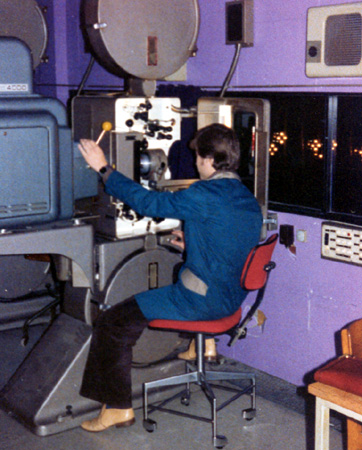 Rene
Pfaff operating the DP70 at Kinopalæet in Copenhagen. Image by Jan Niebuhr Rene
Pfaff operating the DP70 at Kinopalæet in Copenhagen. Image by Jan NiebuhrPhilips originally named the new Todd-AO projector the EL4000/01 in their catalogue, but it quickly became the DP70. The DP is short for "Double Projector" and the "70" meant it was designed specifically as a 70mm projector. It is interesting to note that in the state of Victoria, Australia, it was known as EL4000 and in the state of New South Wales, also Australia, it was known as DP70. Philips Cinema and Jan Kotte nicknamed the projector the "Dollar Princess" because they made a considerable amount of money developing it for Magna Theatre Corporation. In the United States it simply became the "Todd-AO projector Catalogue 3070". Later the name was changed to "Universal 70/35" and finally from 1963, it became the "Norelco AAII". AA was very likely short for “Academy Award”. II meant “Version 2” because of the many new changes and improvements introduced to this model after winning the OSCAR. |
|||||||||||||||||||||||||||||||||||||||||||||||||||||||||||||||||||||||||||||||||||||||||||||||||||||||||||||||||||||||||||||
Cine Apergons - The Todd-AO projection lens |
|||||||||||||||||||||||||||||||||||||||||||||||||||||||||||||||||||||||||||||||||||||||||||||||||||||||||||||||||||||||||||||
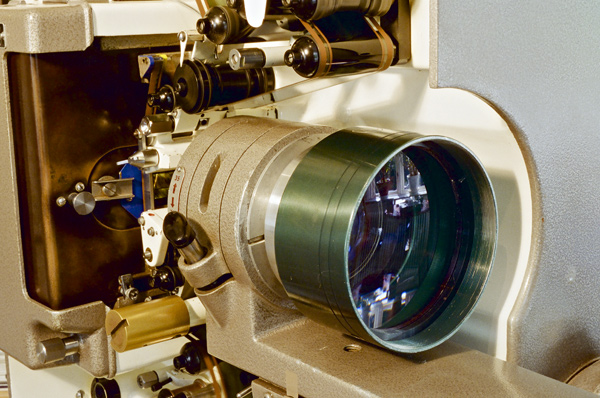 Todd-AO Cine Apergon Todd-AO Cine ApergonThe Todd-AO projection lenses, known as Cine Apergons, were specially designed by American Optical Company for each cinema (so the press said) with aspherical surfaces on some of their elements. Cine Apergons were available in these basic focal lengths • 2,6" = 66mm • 3" = 76mm • 3,5" = 89mm • 4,1" = 104mm • 5,6" = 142mm • 6,6" = 168mm With a green magnifier, intermediate focal lengths could also be obtained. They were very sturdy and heavy lenses. The pair used in Copenhagen almost "painted" an extremely sharp 70mm image on the curved 17 meter Todd-AO screen. Always in focus, great contrast and very bright images. • Go to 70mm film projection lenses for the DP70 |
|||||||||||||||||||||||||||||||||||||||||||||||||||||||||||||||||||||||||||||||||||||||||||||||||||||||||||||||||||||||||||||
Where were projectors manufactured? |
|||||||||||||||||||||||||||||||||||||||||||||||||||||||||||||||||||||||||||||||||||||||||||||||||||||||||||||||||||||||||||||
 On
top of this Philips building in Eindhoven, Holland, all Philips' cinema
projectors were enginered. The location was called "ELA" which
is short for Electro Acoustive Division. There was a cinema in which the
cinema equipment was installed, including a DP70. Picture by Editor. On
top of this Philips building in Eindhoven, Holland, all Philips' cinema
projectors were enginered. The location was called "ELA" which
is short for Electro Acoustive Division. There was a cinema in which the
cinema equipment was installed, including a DP70. Picture by Editor.All projector mechanisms were made in Holland in series of 100 at a time. (Source: In The Splendour of 70mm. Preserving Wide Film History, (DE: "Die Herrlichkeit von 70mm") by Grant Lobban). Other projector parts (lower base, upper base, spool boxes, mounting table for lamp house) were also made in the United States by American Optical Company and are clearly noted: "Made in Buffalo, New York". Some projectors were marked "Property of the Michael Todd Company, Inc". In the US brochure dated S-61 (probably 1961) parts were made in Mount Vernon, New York. Projector parts made in the USA carry a serial number on the upper base with a production year and a production number. An example is 59-175. Later models only carry a 4-digit serial number. |
|||||||||||||||||||||||||||||||||||||||||||||||||||||||||||||||||||||||||||||||||||||||||||||||||||||||||||||||||||||||||||||
Shipment |
|||||||||||||||||||||||||||||||||||||||||||||||||||||||||||||||||||||||||||||||||||||||||||||||||||||||||||||||||||||||||||||
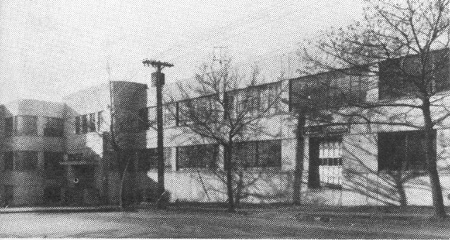 Parts
for the machines in the US were made here at this factory. Image by Philips Parts
for the machines in the US were made here at this factory. Image by PhilipsIn the fall of 1955, fifty DP70 projectors were shipped from Holland to the United States for the Michael Todd Company, Inc. Those fifty machines were most likely numbered from no 601 - 650 as being the first batch of DP70 machines. Fifty machine would be sufficient to equip 20-22 cinemas for the roll out of Todd-AO in the US for the premiere of "Oklahoma!". Normally two projectors would go into a cinema, but sometimes three were needed. Usually a theatre installation consisted of two machines in the projection room. A left and a right projector (as seen from the rear of the machines toward the screen). But in some cases three and four machines were needed in the most prestigious cinemas. A four-projector example is the Palais de Festival in Cannes and Musee du Cinema (1998) in Paris, both in France. Today it is not unusual to find a one-projector installation. The DP70 also works with platters (non-rewind/cake stands) and towers. The first cinema to get the DP70 was The Rivoli Theatre in New York, to be able to host the World Premiere of Todd-AO and the first feature; Fred Zinnemann's "Oklahoma!" in Todd-AO on October 10, 1955. Rivoli was unique in the sense, it was also the Todd-AO demonstration cinema for the Todd-AO Corporation, and had two projection rooms on two different levels. A total of at least five DP70 machines went into the Rivoli. Two in the original projection room at the top, and three at the Mezzanine level. One of Mike Todd's important requirements for the new systems was to be able to install Todd-AO in ANY theatre without expensive rebuilding. That often meant to install DP70s in the original projection room in the back at the very top of the balcony. Projection from the original projection room meant a very steep down angle of throw, which resulted in some heavy distortion on the new curved Todd-AO screen. The projection problems was addressed by the American Optical engineers with the unique Distortion Correcting Printing Process. It did work but was ultimately also abandoned because of technical imperfections. At the Rivoli, "Oklahoma!" premiered like that (a "rectified" print from the upper projection room), but it wasn't long until the Mezzanine level projection room was put into use, with head-on projection from three DP70s. Todd-AO installations in the US were planned and carried out by The Todd-AO Corporation. The speed of installing Todd-AO equipment in the US went slower than expected due to the lack of film in the Todd-AO process. By late 1955 the first four Todd-AO cinemas were: 1: 10.10.1955: The Rivoli, New York, USA (five machines) 2: 17.11.1955: Egyptian, Hollywood, USA 3: 24.12.1955: Los Angeles, Hollywood, USA 4: 26.12.1955: McVickers, Chicago, USA -, followed by 24 additional "Oklahoma!" in Todd-AO installations all over North America: |
|||||||||||||||||||||||||||||||||||||||||||||||||||||||||||||||||||||||||||||||||||||||||||||||||||||||||||||||||||||||||||||
Todd-AO outside the US |
|||||||||||||||||||||||||||||||||||||||||||||||||||||||||||||||||||||||||||||||||||||||||||||||||||||||||||||||||||||||||||||
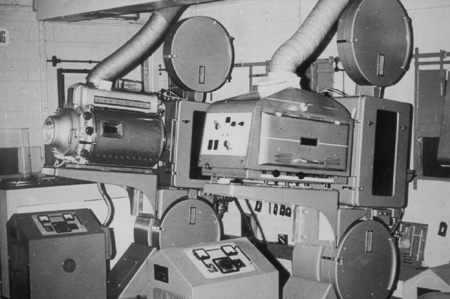 A pair of DP70 at Manchester Film Theatre, Manchester, England, 1969. Believed to be the last pair of DP70's to come out of Eindhoven in 1968. Image by Don Sykes A pair of DP70 at Manchester Film Theatre, Manchester, England, 1969. Believed to be the last pair of DP70's to come out of Eindhoven in 1968. Image by Don SykesNews about Todd-AO soon spread to foreign markets, including Japan, Australia and Europe. By the time of the 1956 Photokina Exhibition in Cologne, Germany (29. September - 7. October) there were 21 Todd-AO cinemas in the US and Canada, and none elsewhere. Philips had a big Photokina exhibition, with a full range of film projectors from their "Family Projector" series (FP4, FP5, FP56 etc). The centerpiece was their brand new DP70 and a big curved screen. For demonstration purposes, Louis de Rochemont's "The Miracle of Todd-AO" was shown many times and impressed cinema owners. Foreign exhibitors were thrilled to see the Todd-AO demonstrations and soon lined up to order the new equipment from Philips's factories in Eindhoven. Especially German exhibitors. Germany was a big market for DP70, as most of the cinema industry was in ruins after the Second World War. By 1957 there were nearly 60 Todd-AO installations in the US. Germany, Italy, Malta and Japan were about to get Todd-AO. By 1958, Todd-AO premiered in Denmark, Switzerland, France, Holland, Australia, Ireland and New Zealand. By the end of 1958 there were already ten DP70 installations in England (UK). Roll out of Todd-AO DP70 cinemas by date and country: 13.10.1955. The Rivoli Theatre, New York, USA ("Oklahoma!") 25.04.1956. Tivoli, Toronto, Canada 28.12.1956. Shinjuko Koma Stadium, Tokyo, Japan 14.02.1957. Adriano, Rome, Italy 14.03.1957. Savoy, Hamburg, Germany 21.04.1958. Dominion, London, UK ("South Pacific") 01.05.1958. USA Theatre EXPO 1958, Bruxelles, Belgium 22.09.1958. Gaumont, Glasgow, Scotland 24.10.1958. 3 Falke Bio, Copenhagen, Denmark 25.10.1958. Apollo Cinerama, Zürich, Switzerland 12.12.1958. Plaza, Auckland, New Zealand 17.12.1958. Ermitage, Paris, France (July 9th 1958 Cinema ERMITAGE in English Cinema MAX LINDER in French) 19.12.1958. Asta Cinema, The Hague, Holland *) 26.12.1958. Mayfair, Sydney, Australia 26.12.1958. Adelphi, Dublin, Ireland 07.04.1959. Ritz, Stockholm, Sweden 23.09.1959. Cine Paz, Madrid, Spain 20.12.1960. Gartenbau Kino, Vienna xx.xx.1966. Madeira, Portugal and also here: Luxor, Buenos Aires, Argentina Plaza, Sliema, Malta Regal, Kingston, Jamaica Colosseum, Oslo, Norway Monumental, Lisbon, Portugal Forum, Moscow, Russia Rizal/Galaxy, Manila, Philipines Cine Olimpo, Caracas, Venezuela Quellin, Antwerp, Belgium *) The first public Todd-AO screening in The Netherlands was "THE MIRACLE OF TODD-AO", from 14.06.1957 during a filmweek in the (non cinema) Kurhaus, The Hague. (Jan-Hein Bal) The first three UK Todd-AO installations were: • London: Dominion • Manchester: Gaumont Theatre • Plymouth: The Drake |
|||||||||||||||||||||||||||||||||||||||||||||||||||||||||||||||||||||||||||||||||||||||||||||||||||||||||||||||||||||||||||||
The DP70 Cinemas |
|||||||||||||||||||||||||||||||||||||||||||||||||||||||||||||||||||||||||||||||||||||||||||||||||||||||||||||||||||||||||||||
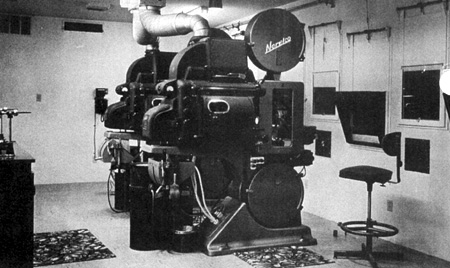 Typical
DP70 installation. Image by Philips. Typical
DP70 installation. Image by Philips.
In the 1950s and '60 it was customary for projector manufactures to keep inventory lists of all their 70mm installations. At least, Philips Cinema maintained a comprehensive DP70 list which they used to sell their products. On the back cover of the original European DP70 Brochure from August 1960, Philips listed 231 cinemas with the DP70. That is approximately 462 machines. Three years later on January 16, 1964 North American Philips Company, Inc. (Motion Picture Equipment Division) released an updated list of DP70 installations with many more cinemas. PDF's of Philips DP70 Brochures • European DP70 Brochure • Norelco AAII Universal 70-35 Projector • North American DP70 brochure The group of cinemas equipped with the DP70 is very long and impressive. Many of the world's most prestigious cinemas had the "Rolls-Royce" of 70mm projectors installed. • By November 1959 there were __ cinemas with the DP70 in Europa and the far east, and the the number of Todd-AO installations had increased to 86 in the US and Canada. • By January 1960 there were 34 cinemas with the DP70 (19 CMA and 15 ABC) in Great Britain. • By May 1960 there were __ cinemas with the DP70 in the US and Canada • By August 1960 the DP70 was installed in 231 venues = 462+ machines (US and rest of the world). • By OSCAR Night, in March 1963, there were 525 DP70 installations (= more than 1050 machines) in 39 countries. • By 1964 Norelco AAII / DP70 Theatre List (world) By December 1964 more than 1100 cinemas worldwide had 70mm installed. Most of them were with the DP70. During the 1966 Photokina exhibition (in Cologne, Germany), Philips Cinema presented the new DeLuxe Projector for 35/70mm, widely know as the DP75 and production of the popular DP70 finally came to an end. • Go to DP70s in Cinemas All over The World |
|||||||||||||||||||||||||||||||||||||||||||||||||||||||||||||||||||||||||||||||||||||||||||||||||||||||||||||||||||||||||||||
The DP70 Serial Numbers - How many DP70 were made? |
|||||||||||||||||||||||||||||||||||||||||||||||||||||||||||||||||||||||||||||||||||||||||||||||||||||||||||||||||||||||||||||
 The
serial number is the small metal plate on the back of the mechanism between
the two oil taps, or on earlier models, just above the shutter. The
serial number is the small metal plate on the back of the mechanism between
the two oil taps, or on earlier models, just above the shutter.
That is a question which I have been trying to
find the answer
to for many years. The short answer is 1577 machines. This is a qualified guess, based
on all the numbers in this list. "Huh! How is that?" Well, since the early 1980s I
have been collecting DP70 serial numbers as a hobby. Whenever I visited a cinema
with one or more DP70s I wrote the number down, and recorded the theatre name. Over
time, many friends and projectionists have sent me similar information, and
to date, this list now includes nearly 700 machines. The list of serial DP70 numbers has been assembled over nearly 40
years and
serves no other purpose than being a very needy interest, but also a work of love. |
|||||||||||||||||||||||||||||||||||||||||||||||||||||||||||||||||||||||||||||||||||||||||||||||||||||||||||||||||||||||||||||
 This
in not the DP70 serial number plate. It is the
American Optical Company upper base plate. This number plate is only seen on the
DP70 base in the United States.
Plates like this have the following number ranges: 59-- _ _ _.
1 _ _ and
6 _ _ _ This
in not the DP70 serial number plate. It is the
American Optical Company upper base plate. This number plate is only seen on the
DP70 base in the United States.
Plates like this have the following number ranges: 59-- _ _ _.
1 _ _ and
6 _ _ _I have been unable to find precise information as to the exact number of machines manufactured. It will remain a total mystery how many DP70 projectors Philips Cinema manufactured from 1955 until the end, around 1966. The Philips company has been very helpful, but alas, have been unable to find any records. Kinoton was kind to reply in 2001, and they estimated around 1500 machines had been built. Kinoton was located in Munich, Germany, and became the distributor of spare parts for the DP70.
If I assume that all numbers collected so far gives a random image of all
the machines ever made, then my guess is that Philips Cinema made 1577 DP70 Todd-AO projectors. In the
table, you can see a breakdown of each series with my
notes.
The list is not complete, nor will it ever be, but it does give a very good
depiction of how popular the Todd-AO Projector was. Especially since everything
Todd-AO is now long gone in Hollywood, and digital cinema has taken over mainstream cinema, we still have the original 70mm projector left in many
cinemas. Perhaps the most successful element of the entire Todd-AO Process?
|
|||||||||||||||||||||||||||||||||||||||||||||||||||||||||||||||||||||||||||||||||||||||||||||||||||||||||||||||||||||||||||||
"And the OSCAR Goes to...PHILIPS"
|
|||||||||||||||||||||||||||||||||||||||||||||||||||||||||||||||||||||||||||||||||||||||||||||||||||||||||||||||||||||||||||||
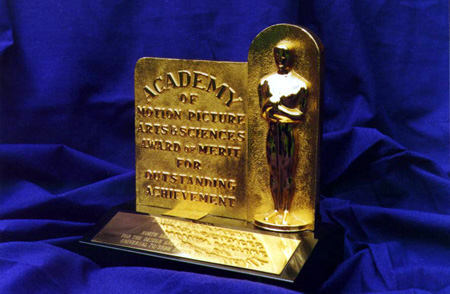 In the early 1960s Philips Cinema was one of the largest Cinema Equipment
suppliers in the world and Jan J. Kotte's projector quality was unrivalled. The DP70 was the
crown jewel in a long line of Philips machines which included: FP4, FP5, FP56,
FP20 and FP30. In the early 1960s Philips Cinema was one of the largest Cinema Equipment
suppliers in the world and Jan J. Kotte's projector quality was unrivalled. The DP70 was the
crown jewel in a long line of Philips machines which included: FP4, FP5, FP56,
FP20 and FP30. The DP70 was extremely gentle to 70mm film, and allowed many passes through the gate, without significant wear and tear. How many 70mm projectors will allow one 70mm print 1600 passes? That was the case in London and the Dominion Theatre's record breaking "South Pacific" 4-year run. One Todd-AO print was shown from 21.04.1958 until 30.09.1962 London. The DP70 was truly a remarkable 70mm projector and on Monday April 8, 1963 Fred J. Pfeiff, Technical Manager of the motion picture equipment department of Norelco (North American Philips), received the 1962 Class 2 Oscar plaque for on behalf of the Philips company:
Actually there were two OSCARS made. The
original OSCAR was was awarded to the Philips Company and brought back to Europe
by Mr. Kees Nijsen, who was
Sales
Promotion & Advertising Manager of Philips Cinema's Publicity department. The
Philips company ordered a second OSCAR to award to Mr. Jan Kotte personally in
appreciation of his dedication to Philips. The 1962 Award (given in March 1963)
was the first ever given to a projector in the Academy's history. The OSCAR was well deserved. The DP70 was, and still is, the "Rolls Royce" of 70mm
projectors. In 1999 the IMAX projector, with the unique rolling loop principle,
was also awarded a similar award.
•
Go to
A Brief History of Philips
Cinema |
|||||||||||||||||||||||||||||||||||||||||||||||||||||||||||||||||||||||||||||||||||||||||||||||||||||||||||||||||||||||||||||
Which is the longest running DP70? |
|||||||||||||||||||||||||||||||||||||||||||||||||||||||||||||||||||||||||||||||||||||||||||||||||||||||||||||||||||||||||||||
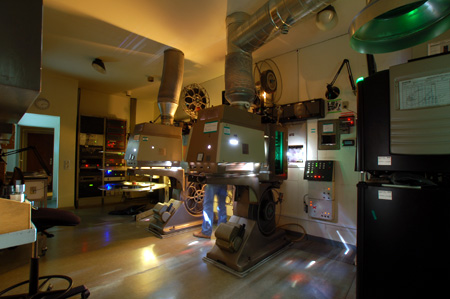 DP70s
1640+1644 at Imperial Bio, Copenhagen, Denmark - perhaps the longest running
original DP70 installation. DP70s
1640+1644 at Imperial Bio, Copenhagen, Denmark - perhaps the longest running
original DP70 installation.Most of the original cinemas do not exist any longer. They have either been closed, demolished or rebuilt into multiplexes. If they still exist, it is unusual to find the DP70s still installed. In one case, however, that is possible. The Imperial Bio (Copenhagen, Denmark), had a pair (1644 and 1640) installed in 1961, when the cinema opened. Both machines were still operational until December 2011, when #1640 was scrapped on the spot to make room for a 4K digital projector. They had been running continuously since 1 November 1961. Surely a world record - 50 years of service. #1644 is still used for the occasional 70mm premiere. |
|||||||||||||||||||||||||||||||||||||||||||||||||||||||||||||||||||||||||||||||||||||||||||||||||||||||||||||||||||||||||||||
Competitive 70mm projectors and DP70 Clones |
|||||||||||||||||||||||||||||||||||||||||||||||||||||||||||||||||||||||||||||||||||||||||||||||||||||||||||||||||||||||||||||
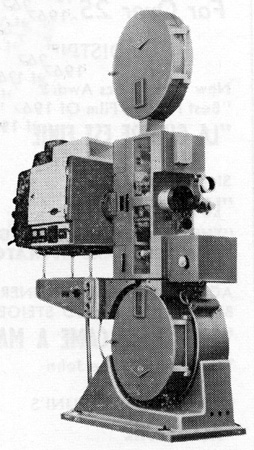 Japanese Toshiba Photo Phone Co., Ltd TP 70/35 Imperial Japanese Toshiba Photo Phone Co., Ltd TP 70/35 ImperialAfter the initial premiere of Philips' DP70, other projector manufactures started to develop 70mm projectors in Brazil, Germany, Italy, Japan, Russia, and the USA. New 70mm projectors included: • Eugen Bauer U2 • Cinemeccanica Victoria X • Incol 70-35 • Russian KTT15-A • Toshiba Photo Phone Co., Ltd TP 70/35 Imperial • Century JJ -, and many more: 70mm Film Projectors The DP70 also inspired at least three different 70mm machines, which have striking similarities with the DP70. The Toshiba Photo Phone Co., Ltd. in Japan introduced their TP 70/35 Imperial projector (Motion Picture Almanac 1972 page 64A). Spool boxes, lower- and upper bases were more or less identical to the DP70. Another interesting DP70 "look-a-like" projector was the Russian KTT15-A. This projector does not look like a DP70 at all on the outside. Inside, however, some striking similarities were apparent. The lens mount bracket, 70mm film gate and the shutter were a very close variation of the DP70. The Incol 70-35 from Brazil has a film gate which has striking similarities with the DP70. |
|||||||||||||||||||||||||||||||||||||||||||||||||||||||||||||||||||||||||||||||||||||||||||||||||||||||||||||||||||||||||||||
Automation of a DP70 or Disposal |
|||||||||||||||||||||||||||||||||||||||||||||||||||||||||||||||||||||||||||||||||||||||||||||||||||||||||||||||||||||||||||||
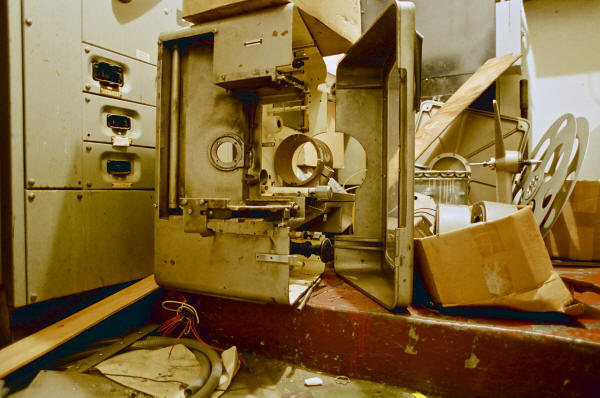 Cannibalized
DP70 681. Image by Thomas Hauerslev, 1994 Cannibalized
DP70 681. Image by Thomas Hauerslev, 1994The DP70 had not been made for automation, remote control and multiplex operation. With increasing demand for cost saving, theater owners started to break up cinemas into several screens and cut down on projection staff. There was a need for cinemas to be automated. In the late sixties Rank Film Ltd. became distributor of Cinemeccanica's projectors in England. DP70s were removed in more than 20 ODEON cinemas and replaced by the popular Italian Cinemeccanica Victoria 8 70mm projector. The Cinemeccanica Victoria 8 can be fully remote controlled. A VERY expensive decision by Rank facing the increasing competition. Some of these DP70s went to the United States, but most of them were scrapped only after a few years of service. Much to the frustration of many projectionists and DP70 devotees. There are reports that many ODEON DP70s were literally scrapped with a large hammer [Source: Dion Hanson]. The reason for this is unknown. A similar thing happened in Australia when Hoyt's theatres, a large cinema chain, automated all their cinemas. Those DP70 not needed were given away to those who were interested. The rest were thrown away into the Tasmanian Sea or even used as boat anchors in Sydney harbor! There is no evidence of this statement, but it is colorful.
|
|||||||||||||||||||||||||||||||||||||||||||||||||||||||||||||||||||||||||||||||||||||||||||||||||||||||||||||||||||||||||||||
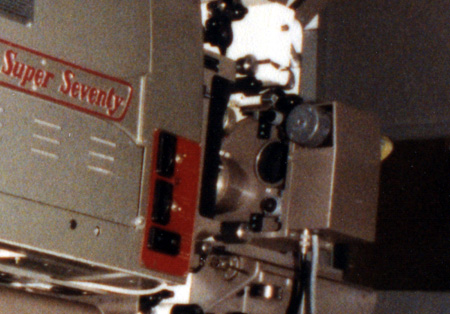 Lens
turrent in Austria Lens
turrent in AustriaBut as theatres were closing in the '60s and '70s, a lot of theatre owners had the problem of disposing of equipment that had no resale value, and the DP70 had not reached the cult following that it now has, so many were simply thrown out. It is interesting to note that Hoyt's in Australia did not buy another Philips projector for about 10 years after DP70 production ceased. During this time they bought Cinemeccanica Victoria 8s. In 1976 Hoyt's again began to buy Philips machines mostly FP20s but also some DP75s for new locations. From South Africa there are reports of an actual burial of a DP70! Back in England, the ABC cinema group also replaced some DP70s with the brand new DP75. Most DP75 installations were set up for the 70mm presentations of “Doctor Zhivago” (in 1966). Many DP75 installations were new 70mm installations. Some ex-ABC DP70s went to the United States. In the early 1990s some DP70s were still maintained by Steven Krams and his company in Florida and he had at least 20 machines in stock. |
|||||||||||||||||||||||||||||||||||||||||||||||||||||||||||||||||||||||||||||||||||||||||||||||||||||||||||||||||||||||||||||
Modernizing the DP70 |
|||||||||||||||||||||||||||||||||||||||||||||||||||||||||||||||||||||||||||||||||||||||||||||||||||||||||||||||||||||||||||||
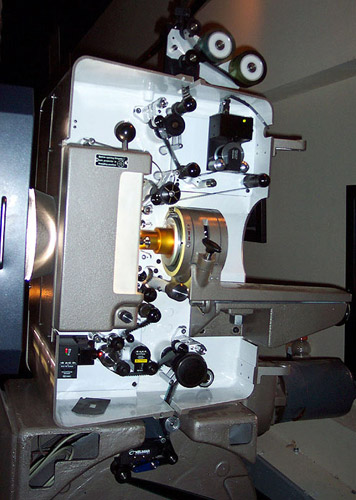 A
beautifully restored DP70
with internal DTS reader and reverse scan reader. Image by Mark Gulbrandsen A
beautifully restored DP70
with internal DTS reader and reverse scan reader. Image by Mark GulbrandsenFrom the beginning more than 50 years ago, the DP70 has been considered one of the best projectors ever made. Despite that, Philips continued to improve the machine until production ended around 1966. Since then, and especially during the 1990s, the DP70 was still being upgraded, by Kinoton and other cinema supply companies. Some machines were converted to play 8 perf 70mm prints, and at least one machine in Austria was equipped with a lens turrent. And recently, Rosbeek Techniek in Holland have made a new 35mm film gate and a three-bladed shutter for the DP70. More improvements: • Photo mask by Todd-AO • A new film gate for the DP70 projector • The Century Cinefocus • DP70 RED-LED reverse scanner • DP70 reverse scanner • New film gate for the DP70 • Go to Modernizing the DP70 to see all examples. |
|||||||||||||||||||||||||||||||||||||||||||||||||||||||||||||||||||||||||||||||||||||||||||||||||||||||||||||||||||||||||||||
The end of an era and new use of old machines |
|||||||||||||||||||||||||||||||||||||||||||||||||||||||||||||||||||||||||||||||||||||||||||||||||||||||||||||||||||||||||||||
|
By the mid 1990s, used DP70 projectors were sold at very high prices.
USD $10.000 was not an unlikely price for a projector fully reconditioned and
in perfect working order. Worn and badly maintained projectors are much cheaper
of course. It is not only film collectors and projectionists who appreciate the
DP70. Until the introduction of digital cinema, many prestigious cinemas, laboratories and film studios like Technicolor
Ltd., Todd-AO, 20th Century-Fox and Warner Brothers in Hollywood had DP70s installed. Todd-AO in Hollywood had
six
projectors and Paramount Pictures at 5555 Melrose in Hollywood runs at least
five
machines. Film museums in Amsterdam, Oslo, Stockholm, Paris, London, Bradford, and
Hollywood, also install the DP70. And with good reason, as the DP70 remains the
most desirable of 70mm projectors. However, hard as it may seem, 70mm projection and 6-track stereo in a private theatre in the basement is not uncommon. As digital projectors have found their way into projection rooms across the world, many film machines have been simply given away, cannibalized or thrown away. A surprising number of DP70 projectors have found a safe home in the hands of DP70 devotees who restore them to original glory. Some people even strip them and have them completely repainted in the original Phillips Hammertone Epoxy paint. |
|||||||||||||||||||||||||||||||||||||||||||||||||||||||||||||||||||||||||||||||||||||||||||||||||||||||||||||||||||||||||||||
Legacy of the DP70 |
|||||||||||||||||||||||||||||||||||||||||||||||||||||||||||||||||||||||||||||||||||||||||||||||||||||||||||||||||||||||||||||
 Mr
Anton Kotte (left) and Mr. Nijsen photographed in May 1998 in Eindhoven, Holland by Thomas
Hauerslev Mr
Anton Kotte (left) and Mr. Nijsen photographed in May 1998 in Eindhoven, Holland by Thomas
HauerslevA respectable number of DP70s are still running today, nearly 65 years after the first one came of the assembly line in Eindhoven, Holland. A well kept DP70 will (probably) never fail in operation. The DP70 is a beautiful projector, outstanding craftsmanship and a piece of contemporary art from the 1950s. Best said by Trevor Wilson in April 2006:
The
DP70 projector is arguably the most successful part of the Todd-AO system.
Despite the arrival of digital cinema, the DP70 can still be found in
analogue cinemas here and there. |
|||||||||||||||||||||||||||||||||||||||||||||||||||||||||||||||||||||||||||||||||||||||||||||||||||||||||||||||||||||||||||||
DP70: A Hobby Odyssey |
|||||||||||||||||||||||||||||||||||||||||||||||||||||||||||||||||||||||||||||||||||||||||||||||||||||||||||||||||||||||||||||
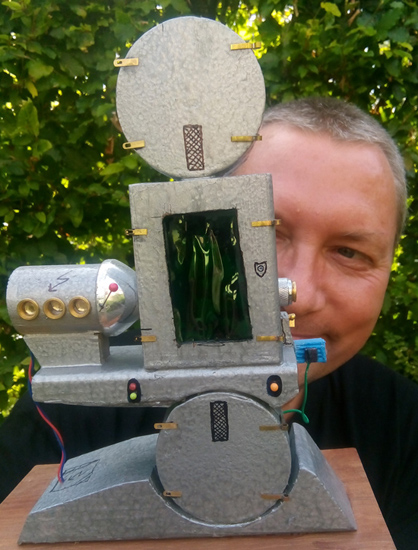 In
1982, as a teenager, I started my film-life as a projectionist apprentice at the
3 Falke Bio, my favourite cinema which was "purpose built" for Todd-AO in 1958. My new interest became the history of the Philips DP70 projector.
I was intrigued and wondered "Why did the DP70 receive an OSCAR and what was
Todd-AO?". My collection of DP70 information started to build and soon I discovered how much the DP70 was appreciated everywhere.
I also discovered the wonderful story about Todd-AO and have spent a lot of effort and time to document the Todd-AO process and the DP70 projector.
I remember finding the original
European DP70 Brochure with a list all DP70 installations by August 1960.
I started to collect DP70 serial numbers from Copenhagen, and soon expanded the search to
the rest of Denmark and soon
to Malmø in Sweden and in Hamburg in Germany. In
1982, as a teenager, I started my film-life as a projectionist apprentice at the
3 Falke Bio, my favourite cinema which was "purpose built" for Todd-AO in 1958. My new interest became the history of the Philips DP70 projector.
I was intrigued and wondered "Why did the DP70 receive an OSCAR and what was
Todd-AO?". My collection of DP70 information started to build and soon I discovered how much the DP70 was appreciated everywhere.
I also discovered the wonderful story about Todd-AO and have spent a lot of effort and time to document the Todd-AO process and the DP70 projector.
I remember finding the original
European DP70 Brochure with a list all DP70 installations by August 1960.
I started to collect DP70 serial numbers from Copenhagen, and soon expanded the search to
the rest of Denmark and soon
to Malmø in Sweden and in Hamburg in Germany.
I wrote letters to cinemas and soon
answers arrived with serial numbers and pictures from fans all over the
world. This was amazing! Imagine the thrill to receive a letter from The Todd-AO Corporation in Hollywood with serial numbers and images of their machines. What
a joy to find 24 machines in
Parisian projection rooms one single
summer day in 1992. The bonus by the end of the day was my ability to say "70mm" and
"DP70" in French - fluently. The list kept growing and I sent out regularly updated lists
to all contributors in return for their help. Today, many years
later, the lists are too long to print, and instead you can find all the
information here on this page.
Installations not mentioned in above mentioned official brochures or lists have
no marking.
It is of
course next to impossible to make a record all DP70 cinemas and serial numbers. Projectors are moved and often re-installed in new
locations. Cinemas open, close and
occasionally the machines are destroyed when cinemas are demolished. When available those details have been included on the
cinema lists. |
|||||||||||||||||||||||||||||||||||||||||||||||||||||||||||||||||||||||||||||||||||||||||||||||||||||||||||||||||||||||||||||
DP70 Hard Facts |
|||||||||||||||||||||||||||||||||||||||||||||||||||||||||||||||||||||||||||||||||||||||||||||||||||||||||||||||||||||||||||||
|
There are
many brochures and details about the DP70. It can easily exhaust even
the most avid fan of the DP70 to read everything. So, if you have had
enough, then just skip the rest of the page, which will cover a weight
analysis, information about the original price, highlights about all the
juicy details of the DP70 features, an in-progress staff list of
employees at
Philips
Cinema
Department's Electro-Acoustics Division (ELA) in Eindhoven and a list of
recommended DP70 / Todd-AO reading. You can even summarize the DP70 story here: UK: DP70: A Story of the Todd-AO Projector DE: DP70: Die Geschichte des Todd-AO Projektors Oh, and there are also a long line of shortcuts, which will take you straight to cinema country by country, which had the DP70 installed. Not forgetting the page about "Modernizing the DP70" and the page with News About the DP70, The Todd-AO Projector. PDF's of Philips DP70 Advertising • Construction of the Philips “All Purpose” projector DP70 • Philips Cinema Equipment News • Multi Purpose Todd-AO Projector • Der Projector DP70 • DP70 Advertising & Promotion |
|||||||||||||||||||||||||||||||||||||||||||||||||||||||||||||||||||||||||||||||||||||||||||||||||||||||||||||||||||||||||||||
The DP70 is Heavy, but not that heavy |
|||||||||||||||||||||||||||||||||||||||||||||||||||||||||||||||||||||||||||||||||||||||||||||||||||||||||||||||||||||||||||||
|
If you consider having a DP70 installed in your living room you must check two
things first. What will your wife say, and will the floor hold? I cannot answer
for your wife, but here is the weight of a DP70: 1 kilogram (kg) is equal to 2.2 pounds (lb). 1 pound (lb) is equal to 0,45 kilograms (kg). |
|||||||||||||||||||||||||||||||||||||||||||||||||||||||||||||||||||||||||||||||||||||||||||||||||||||||||||||||||||||||||||||
|
|||||||||||||||||||||||||||||||||||||||||||||||||||||||||||||||||||||||||||||||||||||||||||||||||||||||||||||||||||||||||||||
What did a DP70 cost Originally? |
|||||||||||||||||||||||||||||||||||||||||||||||||||||||||||||||||||||||||||||||||||||||||||||||||||||||||||||||||||||||||||||
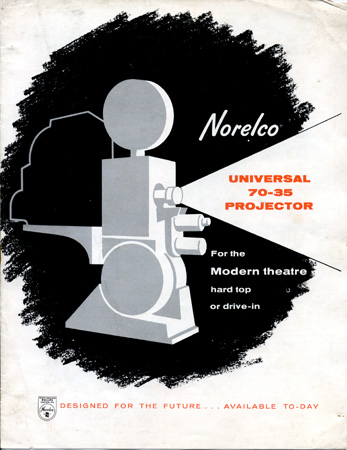 The DP70 was a very expensive 70mm projector to install.
Only the most prestigious cinemas could afford it. Here are the brochures: The DP70 was a very expensive 70mm projector to install.
Only the most prestigious cinemas could afford it. Here are the brochures:PDF's of Philips DP70 Brochures • European DP70 Brochure • Norelco AAII Universal 70-35 Projector • North American DP70 brochure Here are the documents for a complete Todd-AO installation at the Savoy in Hamburg, Germany. The first purpose-built Todd-AO cinema in Europe. Thanks to Stefan Scholz for making the PDFs available. PDF Todd-AO installation, Savoy, Hamburg, Germany • Philips Kaufvertrag, Haus Savoy, Hamburg 1957 • Haus Savoy, Hamburg, Rechnung April 1957 • Haus Savoy, Hamburg, Rechnung December 1957 This one from Craig Binnebose: The Cecil Theatre, Mason City, Iowa. Two DP70 cost USD $6225.00 each. August 10, 1966. Quotation No. 447 from Ballantyne of Omaha. Thanks to Hans Frahm in Johannesburg, South Africa, the 1962 and 1964 price of a DP70 has been found. The price is in the international currency of 1962: British Pound Sterling. The exchange rate was USD $2.80 to the pound. (Until 1964 when it had to be devalued!) |
|||||||||||||||||||||||||||||||||||||||||||||||||||||||||||||||||||||||||||||||||||||||||||||||||||||||||||||||||||||||||||||
|
|||||||||||||||||||||||||||||||||||||||||||||||||||||||||||||||||||||||||||||||||||||||||||||||||||||||||||||||||||||||||||||
DP70
Features
|
|||||||||||||||||||||||||||||||||||||||||||||||||||||||||||||||||||||||||||||||||||||||||||||||||||||||||||||||||||||||||||||
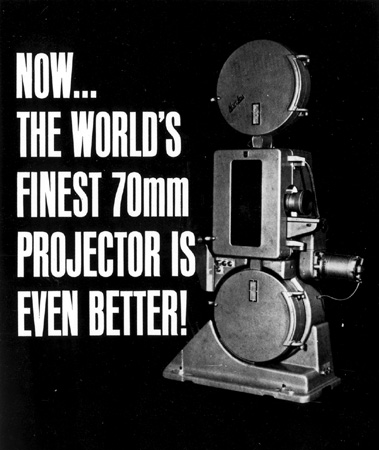 •
Fully compatible
with, and quickly convertible for 70mm or 65mm film with up to six magnetic
sound tracks, 35mm CinemaScope with four magnetic or single optical sound
tracks, and Perspecta-sound, Wide Screen film of any aspect ratio with
either magnetic or optical sound and standard 35mm film. •
Fully compatible
with, and quickly convertible for 70mm or 65mm film with up to six magnetic
sound tracks, 35mm CinemaScope with four magnetic or single optical sound
tracks, and Perspecta-sound, Wide Screen film of any aspect ratio with
either magnetic or optical sound and standard 35mm film.• Scientifically compounded curve of light gate - prevents film buckle. • Single blade double speed conical shutter, providing highest light transmission of any projector. Leading and trailing edges have integral air scoops that aid in dissipating heat. • Rollers, drums, sprockets and film gate made from non-magnetic materials - eliminates possibility of magnetic soundtrack damage and necessity for frequent degaussing. Dual sprockets on all shafts machined of hardened aluminium alloy. No sprocket change required when changing from 70mm to 35mm or vice-versa. (Less than 4 minutes required.) • Two independent motors on each projector, 24 and 30 fps- all past, present or contemplated 70mm films can be projected without additional expense or modification. • Combined ten-track magnetic clusters, no tricky threading required when changing from six- to four track reproduction. • Triple filtered metered lubrication system. • Substantially constructed for rock steady projection. • All modern, domestic high-power arc lamps adaptable without loss of efficiency. • Lathe bed lens carriage, positive alignment of lens to film path. • Factory installed internal wiring, reduces installation costs. • Adjustable for all projection angles - from 28 degrees downward to the upward angles required in drive-ins. • Complete stock of replacement parts always available. • Fully Underwriters' Laboratories Approved. |
|||||||||||||||||||||||||||||||||||||||||||||||||||||||||||||||||||||||||||||||||||||||||||||||||||||||||||||||||||||||||||||
Norelco
AAII Features
|
|||||||||||||||||||||||||||||||||||||||||||||||||||||||||||||||||||||||||||||||||||||||||||||||||||||||||||||||||||||||||||||
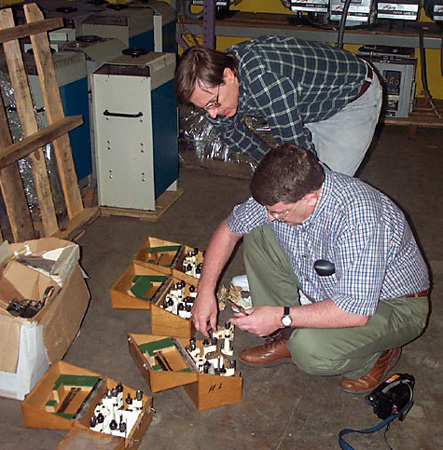 Oak
boxes for 35mm gates. Image by Royce Goldsmith Oak
boxes for 35mm gates. Image by Royce Goldsmith• Dual split 70/35 magazine shafts. Standard 5" hub 35mm reels useable. No longer necessary for theatre to purchase special 35mm reels with 70mm flanges. • New non-glare Plexiglas observation window in projector door. • New threading guards on magnetic shield and idle roller. • New improved intermittent assembly. • New oil vapour leak protection. • New dowser assembly. • Simplified built-in water cooling circuit. • Heavier main drive gear set. • New single motor drive. • New 2-speed clutch for both 30 Frames/sec & 24 Frames/Sec film speed with double "V" belt drive. • New reduced torque motor. • New 4-pole motor start contactor. • Optional optical pre-amplifier. • New easy installation lower compartment door. • New cast aluminium lamp house bracket with adjustable slide for easy alignment of lamp. Provides means for moving lamp without necessity for realignment. Eliminates need for purchase of special adapter previously required for lamps. • New spiral gear take-up drive. • New graphite impregnated nylon idler & pad rollers. • New pre-wired magnetic cluster block. |
|||||||||||||||||||||||||||||||||||||||||||||||||||||||||||||||||||||||||||||||||||||||||||||||||||||||||||||||||||||||||||||
Electro-Acoustics Division (ELA)
|
|||||||||||||||||||||||||||||||||||||||||||||||||||||||||||||||||||||||||||||||||||||||||||||||||||||||||||||||||||||||||||||
|
|||||||||||||||||||||||||||||||||||||||||||||||||||||||||||||||||||||||||||||||||||||||||||||||||||||||||||||||||||||||||||||
DP70 Documentation
|
|||||||||||||||||||||||||||||||||||||||||||||||||||||||||||||||||||||||||||||||||||||||||||||||||||||||||||||||||||||||||||||
|
|||||||||||||||||||||||||||||||||||||||||||||||||||||||||||||||||||||||||||||||||||||||||||||||||||||||||||||||||||||||||||||
DP70 Reference notes |
|||||||||||||||||||||||||||||||||||||||||||||||||||||||||||||||||||||||||||||||||||||||||||||||||||||||||||||||||||||||||||||
|
|||||||||||||||||||||||||||||||||||||||||||||||||||||||||||||||||||||||||||||||||||||||||||||||||||||||||||||||||||||||||||||
|
Go: back
- top - news index Updated 22-01-25 |
